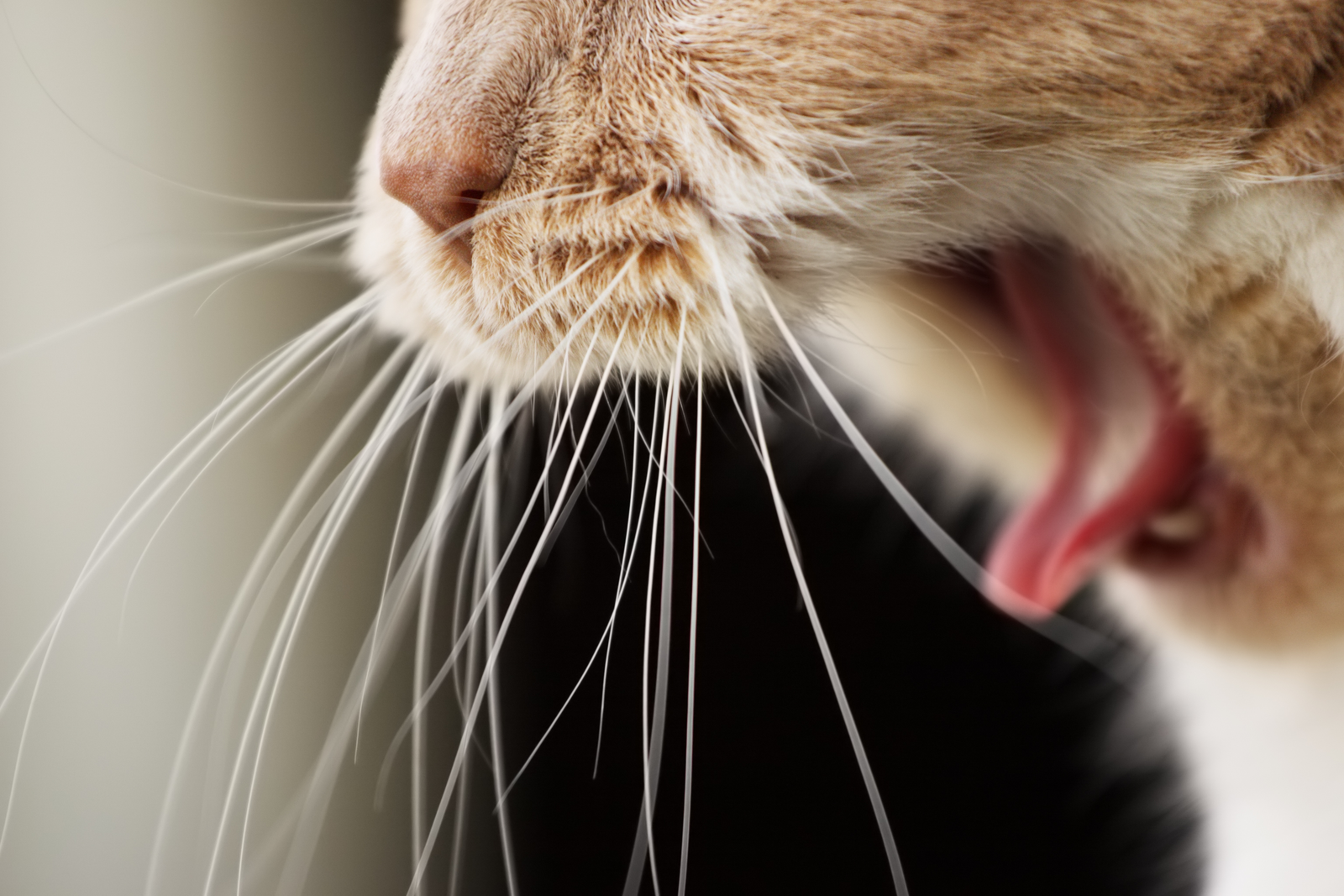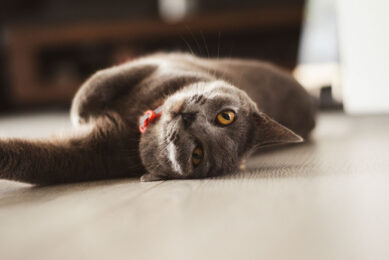Feline hairball control by dietary cellulose

Cellulose-enriched dry and wet cat foods make claims on hairball control. Research data indicate that supplemental dietary cellulose reduces hairball symptoms and raises faecal hair excretion in cats. But the type and amount of ?cellulose determine the efficacy.
Grooming behaviour of cats is associated with the ingestion of fur. Most of the swallowed, non-digestible hair passes through the gastrointestinal tract and is excreted with the faeces. About 10% of shorthaired cats bring up hairballs periodically, the need being around twice as common in their longhaired counterparts (Cannon, 2013). Aggregates of hair formed in the stomach have reached a size that cannot enter the duodenum and will eventually be ejected by vomiting. Occasionally, fur masses obstruct the intestine and cause severe clinical signs and even potentially mortality.
Bringing up hairballs common in pet cats
Normally, gastric hairball formation and elimination is harmless. Bringing up hairballs is common in pet cats and presents an unpleasant nuisance for many owners as they dislike the signs of vomiting, retching and coughing. This situation forms the basis for industrially produced cat foods with a hairball-control claim. When the petfood label declares the ingredients by individual names, powdered cellulose is usually found in the list. The hairball claim is often explained by the food formula moving hair through the digestive tract for faecal voiding.
In her review, Cannon (2013) makes the following statement: “Although a range of commercial hairball control diets are available there is no objective information in the public domain regarding their efficacy.” This article summarises four company and two university reports. Five reports can be found through the internet. One data set is based on an internal university document.
Hairball symptoms
Privately owned cats with signs of gastric hairballs were enrolled in a double-blind, placebo-controlled trial with parallel design (Beynen et al., 2011). For a period of four weeks, the cats (12 per treatment group) consumed a complete dry food without or with 4% (w/w) cellulose. The control diet contained 1.8% crude fibre. To formulate the test diet, 4% of the corn component of the control diet was replaced by the same amount of powdered, fibrillated cellulose with mean fibre length of 200 µm and diameter of 20 µm (Arbocel BWW40, J. Rettenmaier & Söhne GmbH + Co KG). In a booklet with instructions, the owners recorded each day the occurrence of hairball symptoms. The total incidence of symptoms was calculated as the number of events per treatment group per 28 days.
Feeding the test diet lowered the incidence of vomiting, retching and coughing by 79, 91 and 70%, respectively (Figure 1). The cellulose-induced decrease in vomiting was statistically significant. Hoffman and Tetrick (2003) carried out an in-home, cross-over study with feeding periods of 60 days. The cats were fed an adult maintenance diet and a nutritionally similar diet with added fibre. The publication is in abstract form and does not give diet compositions, type and amount of dietary fibre. Personal communication with the second author revealed that dry diets were used. When compared with the control diet, the fibre-enriched diet reduced the number of hairballs reported per household by 21.5% and vomiting frequency by 21.8%.

Figure 1. Feline hairball symptoms as observed in a double-blind, placebo-controlled trial. The cats were fed either the control diet without or the test diet with fibrillated cellulose (Arbocel BWW40, J. Rettenmaier & Söhne GmbH + Co KG). The data are expressed as the cumulative number of times of vomiting, retching or coughing for the two whole groups of cats (n = 12 per dietary treatment) during the entire 28-days experimental period.
Faecal hair excretion
In an experiment with parallel design, three groups, each consisting of eight cats with similar distributions of faecal hair excretion, were fed foods with different amounts of fibre (Tournier et al., 2005). The three diets contained 2.0, 4.5 or 7.8% crude fibre. The report is an abstract that does not mention diet compositions, fibre type and amount. Cats fed the medium- or high-fibre diet excreted 26 or 72% more hair than did their counterparts fed on the low-fibre diet. Baucells and Villaverde (2011) have reported on a cross-over trial with periods of three weeks each in which faecal hair excretion was determined for 20 cats consuming a commercial diet with 2% added fibrillated lignocellulose (Arbocel RC Fine, J. Rettenmaier & Söhne GmbH + Co KG) or 2.5% beet pulp. When the cats were fed the cellulose diet instead of the beet-pulp diet, faecal hair content was 15% higher, the increase being statistically significant. Diets with different fibre compositions have been fed to 11 or 12 cats per diet for four weeks (Davenport et al., 2008).
The patent document does not report diet compositions and the type of cellulose preparation(s) used. After feeding a diet containing 13% cellulose, faecal hair excretion was 2.7 times higher than for a diet containing 12% beet pulp.
In a controlled study with randomised block design, the impact of cellulose and sugar-cane fibre on faecal trichobezoars (hairballs) was measured in 32 cats (Loureiro et al., 2014). The dry control diet contained 13% dietary fibre. The experimental diets had 10% or 20% added sugar-cane fibre, or 10% purified cellulose with mean length of 112 µm (Minérios Ouro Branco Ltda). The fibre additions were done at the expense of the corn component of the control diet. The feeding period lasted 42 days. Faecal hairball excretion was lowered dose-dependently by sugar-cane fibre. The diet with 10% cellulose versus the control diet raised group-mean weight of faecal hairball excretion by 29%. It can be concluded that cellulose addition to the diet of cats specifically raises faecal hair excretion. When compared with beet pulp or sugar-cane fibre, cellulose promotes hair excretion with faeces. The different studies cannot be directly compared, but it seems that hair excretion still increases in the range of 2-13% cellulose in a dry diet.

Bringing up hairballs is common in pet cats and presents an unpleasant nuisance for many owners
Wet pet foods
No studies with wet diets could be retrieved. In the marketplace, renowned companies offer wet hairball-control diets making explicit efficacy claims. The effect of cellulose on hairballs will be exerted by absolute intake rather than dietary concentration. On a dry matter basis, dry and wet foods generally have similar energy densities so that comparable cellulose levels in the dry matter are expected to have equal impact on hairball symptoms.
Mechanism of action
The anti-hairball effect of dietary cellulose as shown in cats is probably based on two synergistic mechanisms. Cellulose may prevent the agglomeration of single strands of hair in the stomach, thereby increasing the transfer of loose hairs into the duodenum. This effect may be greater for fibrillated cellulose prepared by modern and sophisticated milling technology and facilitating the formation of an insoluble fibre network. Cellulose ingestion also accelerates the transit of digesta and thus propels duodenal hair into the faeces. Together, the two mechanisms lead to the observed cellulose-induced faecal excretion of hair. At unchanged grooming behaviour and ingestion of fur, an increase in faecal hair excretion infers less formation of mats of hair in the stomach. Consequently, there will be less vomiting of hairballs.
Practical relevance
Cellulose type will determine the efficacy of hairball control. Preparations forming insoluble networks in the stomach may be more effective. The amount of cellulose in hairball-control diets also affects efficacy, but dose-response studies are not available. For practical application, the open-access publication of a double-blind, placebo-controlled trial (Beynen et al., 2011) is reassuring. The data shows that 4.4% of a fibrillated cellulose preparation in the dry matter of an extruded diet is effective in reducing hairball symptoms in cats. The same dosage in a wet food may be equally effective.
References are available on request from the author (beynen@freeler.nl)











